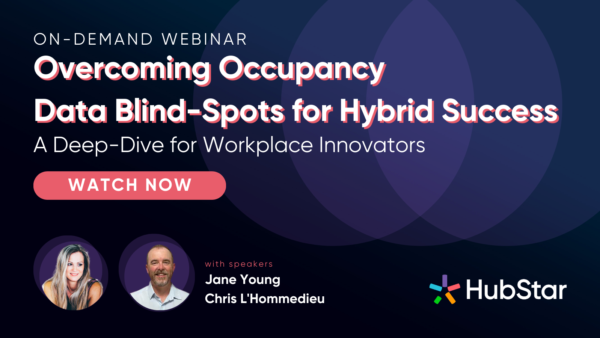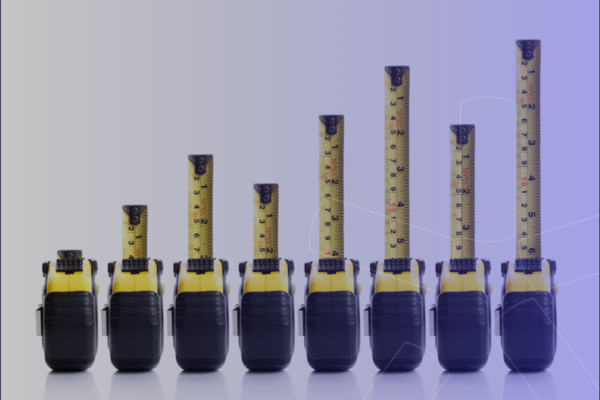Workplace Occupancy Data: Why Hybrid Doesn’t Work Without It

Trying to make hybrid work a success is a lot like taking an armful of groceries to the car without a bag.
As you try in vain to hold onto a bag of apples perched precariously under your chin, the eggs make a bid for freedom and splatter all over the ground.
Pulling off a successful hybrid work strategy is a balancing act of prioritizing the right things. Hold onto cutting real estate costs too hard, for example, and employee experience goes flying onto the pavement.
The world of hybrid work is in such a constant state of change that prioritizing and making the right decisions at the right times is no longer feasible for workplace leaders.
Enter workplace occupancy data – the hefty, heavy duty jumbo grocery bag of hybrid work.
What is workplace occupancy data?
Workplace occupancy data is a measure of how people are using the office.
More specifically, workplace occupancy data reveals office usage patterns, space utilization trends and insights into what makes employees come into the office. When used in the right ways, it tells you what’s working, what’s not, and even predicts the future.
Of occupancy within your office, that is.
Workplace occupancy data should be the basis of all decision-making, from office size and design to hybrid policies and furniture.
Measuring workplace occupancy data in the right ways frees up bandwidth to prioritize the right things at the right times. It makes the overwhelming scale of decisions facing workplace leaders in 2024 a whole lot more manageable.
But there’s a catch – relying on outdated workplace occupancy data sources won’t give you what you need to make impactful decisions.
Overcoming Occupancy Data Blind Spots for Hybrid Success
So what are these outdated workplace occupancy data sources? Funny you should ask. We've covered everything in this on-demand webinar. Check it out!

Here’s why.
You can’t make the right real estate decisions without workplace occupancy data.
Almost half of large organizations expect a reduction in real estate portfolio size, according to a Knight Frank survey of 350 businesses globally. But 55% of all organizations surveyed actually expect their portfolios to increase over the next three years.
Despite recent headlines about companies slashing their square footage, rightsizing the corporate real estate portfolio is a lot more nuanced. The only way to start the rightsizing process for your business is to understand how employees are occupying the office right now.
Making costly real estate decisions without workplace occupancy data runs the risk of landing workplace leaders in one of three categories:
- Downsizing too drastically and damaging employee experience
- Acquiring space that employees won’t use, creating waste
- Not acting quickly enough, incurring both of the consequences above
Hybrid work doesn’t necessarily mean less office space is needed. But it could mean rethinking what the office offers.
You can’t design a successful hybrid office without workplace occupancy data.
Of all employees who report having a great workplace experience, 81% have a choice of where they can work within the office.
Clearly, choice of work environment is central to a great workplace experience. But what should the choices be?
Workplace occupancy data is a big piece of the puzzle when it comes to answering this question. That’s because it reveals so much about the spaces and functionalities employees are getting the most value from.
Consistently low levels of occupancy in areas with individual workstations are a sure fire sign that people aren’t coming in for individual work, for example. Future layout and design decisions should repurpose excess workstations into something employees will use.
Employees come into the office with a purpose – whether that’s to collaborate with colleagues or get some quiet individual working time away from the distractions of home. A successful hybrid office gives employees the best possible environment for the task at hand, from the floor plan configuration down to the plants.
Figuring out what these environments should be is a shot in the dark without occupancy data.
You can’t create a successful hybrid work policy without workplace occupancy data.
By now, it shouldn’t come as a surprise that most employees aren’t huge fans of back-to-the-office mandates.
One in two employees working in finance would look for another job if their managers forced them to spend more time in the office. This is pretty remarkable, considering that financial firms have been the ones blowing the return to office horn the loudest.
Without using workplace occupancy data to understand how people are working right now, any policies on how people should be working will just be wishful thinking.
Heavy-handed mandates destroy trust in leadership and damage employee experience.
Radical departures from previous ways of working that employees found more comfortable require an unfeasible level of change management. For example, a new three day per week hybrid work policy when 75% of the company comes in once per week won’t be realistic.
Insufficiently researched hybrid work policies could even overload the workplace infrastructure, skyrocketing costs, eroding workplace experience and increasing costs and carbon emissions.
Workplace occupancy data is the foundation for a hybrid workplace policy that’s grounded in reality. But it’s also the yardstick for measuring the success of that policy and pinpointing how to make improvements.
But even if a company is measuring workplace occupancy, there’s still a problem.
Most workplace leaders don’t have the right types and quantities of occupancy data to the big decisions with certainty.
How can you make sense of all this data, and how can you trust it?
Check out this on-demand webinar for the answers.
Overcoming Occupancy Data Blind Spots for Hybrid Success
Watch this webinar for a framework on identifying and overcoming blind spots in your occupancy data for a better hybrid workplace.

Share this post






















